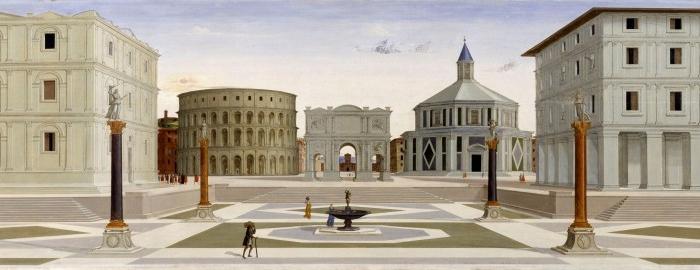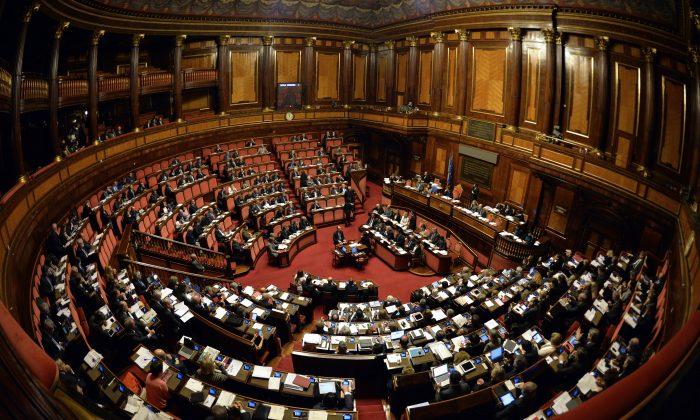Enigmatic paintings on the Renaissance theme of the ideal city are currently on view in Urbino, Italy, at the historic Palazzo Ducale, itself a splendid masterwork of 15th-century Italian architecture.
According to Lorenza Mochi Onori, director general of the Ministry of Heritage and Culture of the Marche Region, Italy, the Urbino Renaissance revolved around the figure of Federico da Montefeltro, Duke of Urbino. Commander and soldier of fortune, Federico was an expert in the construction of objects and machines.
Duke Federico’s education combined with intellectual curiosity and the meeting in his court with figures such as the polymath Leon Battista Alberti and the painter Piero della Francesca—“all of the theoretical perspective,” as Mochi Onori put it—led to a mathematical Renaissance in Urbino during the second half of the 15th century.
Emblematic of this historical period are three depictions of ideal cities, tempera paintings preserved in Urbino; Baltimore, Md.; and Berlin, Germany. The artists of all three paintings are unknown, so the paintings are referred to by the locations of their current owners: Urbino, Baltimore, and Berlin.
While medieval cities were constructed as images of power, domination, and control of the society, the central theme of the Renaissance city is ideal proportion.
“The sense of harmony is felt immediately,” said Mochi Onori, who curated in collaboration with Vittoria Garibaldi the exhibit The Ideal City, subtitled Renaissance utopia in Urbino between the time of Piero della Francesca and Raphael.
The harmony of the ideal city is linked to the vision of the mathematician and Franciscan friar Luca Pacioli, who worked together with Leonardo da Vinci. According to Pacioli, reality, given by divine creation, is governed by mathematical relationships and numerical proportions, with which man reproduces the space.
Using the five regular polyhedra mentioned by Plato, it is possible to “create relationships between spaces, and on the basis of these proportions, one can construct reality in such a way as to reflect this divine harmony,” Mochi Onori said.
The paintings of the ideal cities are not pictorial but mathematical and as such represent an ideal world. By using perspective, thought translates into a construction of reality, and all that the artist conceives is created based on mathematical rules.
“The reality is not made of lines and mathematical constructions, but of atmospheric density, light, and shade, by which the painting is broken in the light and is totally created from light, shadow, and atmospheric density,” Mochi Onori said, referring to different schools of thought.
Even from the viewpoint of colors, we see an ideal representation. The images, in fact, are always clear because the air does not exist. “There is only the mathematical construction, perspective; and the color of the air is not considered,” Mochi Onori said. So the light is always uniform.
There are very few notations of life; from small pots in the windows in the works of Urbino to the figures in the works from Baltimore it seems life was “added afterward to this mathematical space,” she said. This crystalline reality is not corrupted by life, but is the center of human space in order to measure man—a concept taken from the classics.
Ideal Society
During this time in history, the harmony of the ideal city reflected the utopical conception of an enlightened government that respects its citizens’ freedom and, therefore, is able to manage a peaceful and harmonious society.
To illustrate this link between the image of the ideal city and the social order, Mochi Onori gave the example of the Palazzo Ducale in Urbino, the ducal palace and residence of Federico da Montefeltro: “From the architectural point of view, the palace opens onto the city in a direct relationship to emphasize the balance of social relations between power and enlightened society.”
In addition, the relationship between duke and architect became almost one of equals, Mochi Onori said, referring to the architect Leon Battista Alberti, a friend of Duke Federico. The duke did not order the architect to build a city based on size and image; rather they had a relationship of mutual intellectual exchange. And for his architect Luciano Laurana, the duke issued an engineer’s license.
We do not know the purpose or the author of these ideal cities. According to Mochi Onori, the images probably served to decorate furniture, as they were found on chests, headboards, and the backs of benches.
Some speculate the images may have been used for meditation. The contemplation of mathematical reality and order inherent in these representations may induce a state of abstraction from reality and introspection that brings the observer to the beauty of what Luca Pacioli called the “divine proportion.”
Regarding attribution, according to Mochi Onori’s experience with reflectography, an infrared technique used by art historians, the works from Urbino and Baltimore may suggest the same author, a possibility that further fuels the sense of mystery associated with these depictions.
The theme of the ideal city has been present throughout history up to modern drawing-table designs and symbols of political power such as Chandigarh in India or Brasilia. In the Renaissance, however, the design did not aim at building “neighborhoods or cities rationally invented on paper,” as Mochi Onori described, but considered the city as an environment on a human scale.
The paintings of the ideal cities are model representations of reality and a perfect synthesis between the classical art and the rigor of science—unique and unrepeatable as in the case of the mathematical Renaissance of Urbino.
Next to the paintings of the ideal cities from Urbino and Baltimore, the exhibit presents some 50 other paintings, sculptures, inlays, drawings, illuminated manuscripts, and architectural treatises by authors such as Jacopo de Barbari, Mantegna, Bramante, and Raphael. The exhibit is open through July 8.
The Epoch Times publishes in 35 countries and in 19 languages. Subscribe to our e-newsletter.








Friends Read Free